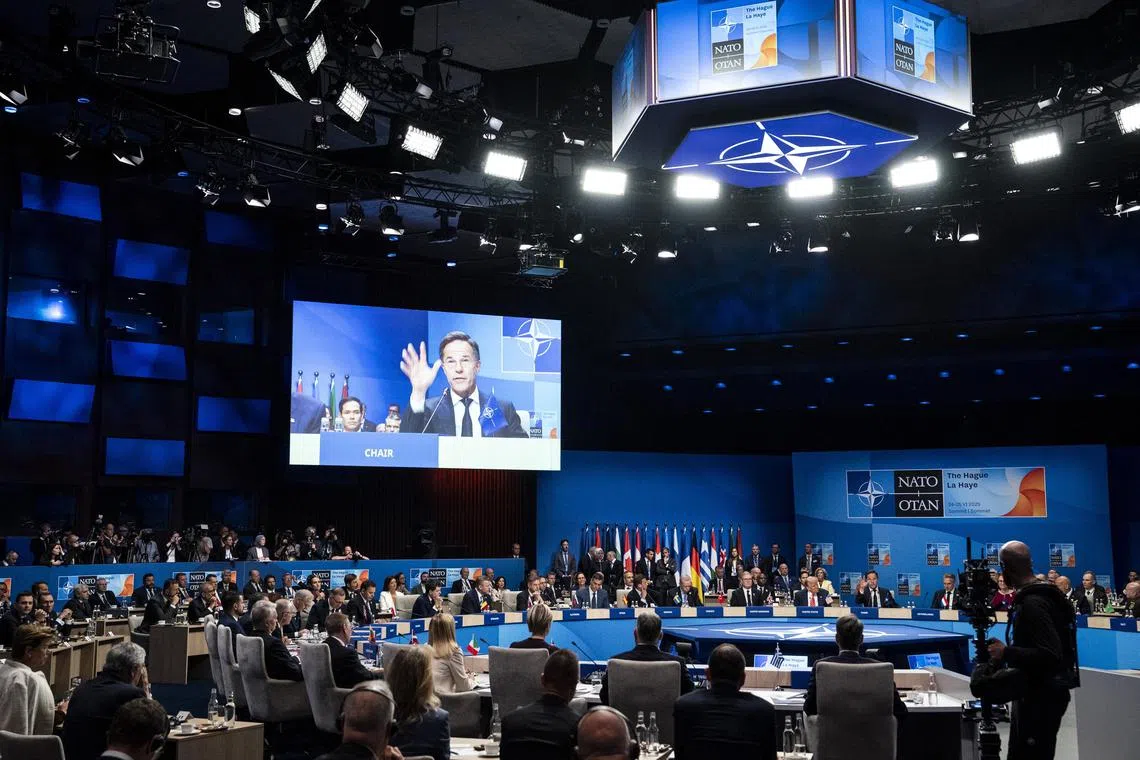Nato’s Trump flattery buys time but dodges tough questions
Sign up now: Get ST's newsletters delivered to your inbox

Nato secretary-general Mark Rutte delivering remarks at the alliance's summit in the Netherlands on June 25.
PHOTO: NYTIMES
Follow topic:
THE HAGUE - Lavishing praise, playing the royal card and copying his slogans – Nato pulled out all the stops to keep US President Donald Trump happy and hold the alliance together at a summit in The Hague.
The plan came off, although it largely avoided tough topics of vital importance to Nato such as the war in Ukraine, Russia strategy and a likely drawdown of US troops in Europe. Sooner or later, Nato will have to deal with them too.
As Nato boss Mark Rutte had planned, the main summit outcomes were a vow by the allies to heed Mr Trump’s call to spend 5 per cent of gross domestic product on defence
That is a far cry from a few months ago, when transatlantic ties were so tense that Mr Friedrich Merz, now Germany’s Chancellor, wondered openly after his election win whether Nato would exist in its current form by the time of the Hague summit.
There was nothing subtle about Nato’s strategy to keep Mr Trump on board. Mr Rutte gushed with compliments in a message to Mr Trump, made public by the US President as he flew to The Hague.
“You will achieve something NO American president in decades could get done,” the former Dutch prime minister said in his message, putting some of his words in capitals like Mr Trump. “Europe is going to pay in a BIG way, as they should, and it will be your win.”
Right before the summit, in another sign of chumminess with Mr Trump, Mr Rutte reacted to the US President’s comments berating Iran and Israel by saying that “daddy has to sometimes use strong language”.
Given Mr Trump’s threats to quit Nato in his first term and not to protect allies who failed to spend enough on defence, the stakes for Nato have been high.
Most Nato members see Russia as an increasingly direct threat to their security following the 2022 invasion of Ukraine, and know they would struggle badly to defend themselves against attack without their nuclear-armed superpower ally.
After the summit, Mr Trump’s previously harsh rhetoric on Nato had been replaced by something very different. “I left here saying that these people really love their countries. It’s not a rip-off, and we’re here to help them, protect them,” he told reporters.
Mr Trump only criticised Spain
Many European nations will find it tough economically to meet the target, but that issue was left for another day.
Charm offensive
As part of Nato’s Hague charm offensive, Mr Trump was granted the rare honour of staying overnight at the ornate royal palace of Dutch King Willem-Alexander before the summit.
The King hosted a three-course meal for leaders prepared by 20 chefs and served by 18 footmen in the baroque 17th-century “Orange Hall” in the Huis ten Bosch palace.
At the start of the summit, other Nato leaders lined up to praise Mr Trump. Lithuanian President Gitanas Nauseda suggested the alliance adopt the motto “Make Nato Great Again”.
Mr Rutte kept the summit short and simple, minimising the risks of any blow-ups with Mr Trump.
Ukrainian President Volodymyr Zelensky had to settle for a seat at the pre-summit dinner rather than the main meeting, although he held a separate meeting with Mr Trump
The summit’s final statement ran to just five paragraphs – compared with 38 in the text from the leaders’ meeting in 2024 in Washington. It does not explicitly describe Russia’s military action in Ukraine as a war or invasion, nor does it repeat or reaffirm a previous pledge that Ukraine will one day join the alliance.
By focusing on reaffirming commitments to Nato and the new spending pledge, it papered over major differences between Washington and many European allies on Russia and Ukraine.
To the discomfort of many Europeans, Mr Trump has taken a more conciliatory stance with Moscow and been less supportive of Kyiv than his predecessor Joe Biden as he seeks to end the war.
While such diplomatic fudges may hold Nato together for now, it will be hard for the alliance to function effectively if there is a major long-term difference between the US and Europe on a question as fundamental as how to handle Russia.
“A Nato summit that essentially ignores the war that is still raging in Ukraine should worry all of us,” said Ms Julianne Smith, who served as the US ambassador to Nato under the Biden administration.
Mr Peter Bator, Slovakia’s former ambassador to Nato, said “we have just missed an opportunity to send a strategic message to the ruler in the Kremlin. And it will cost us in our security”.
Nato officials will now be watching to see whether Mr Trump’s newfound enthusiasm for the alliance is reflected in his administration’s ongoing review of US military posture, as Europe relies heavily on US forces for its security.
European leaders say they are committed to taking on more of that responsibility but are anxious to ensure any transfer is done in an orderly and gradual way.
“You can feel the anxiety when talking to senior European officials about this,” said Ms Oana Lungescu, distinguished fellow at Royal United Services Institute, and a former Nato spokeswoman.
“Most expect the Pentagon to start pulling out some troops and capabilities, but nobody knows how many and how soon.” REUTERS

